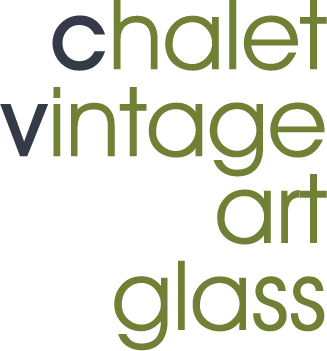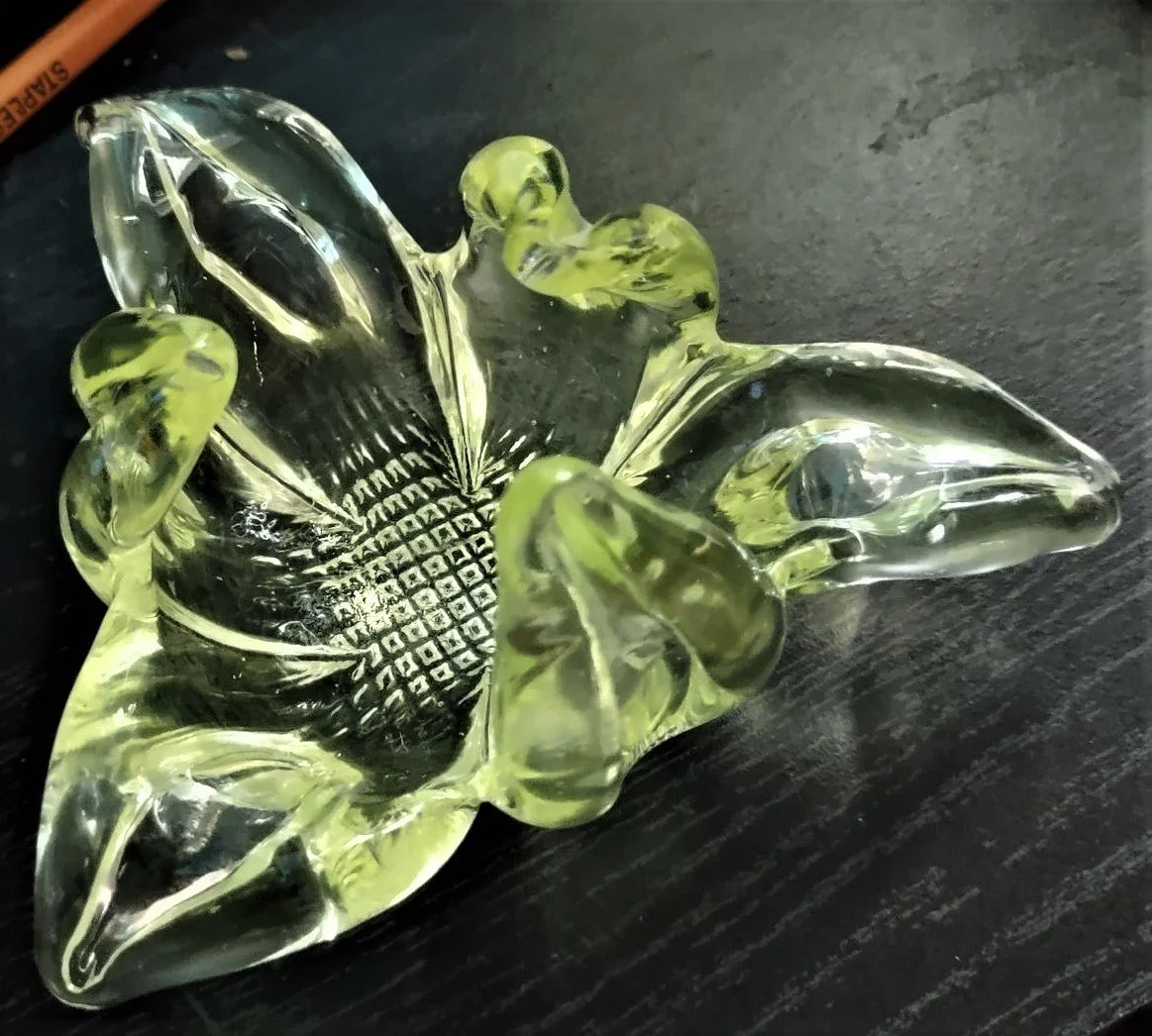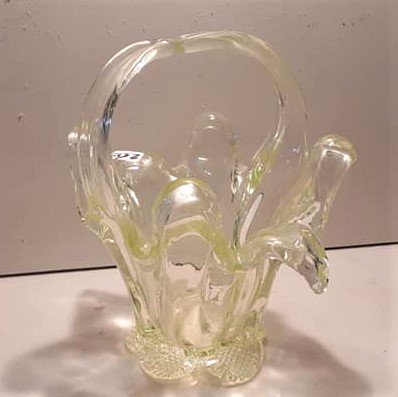Chalet uranium “smalls” – the animals and bonboniere
Uranium oxide, when suitably prepared, produces colours of great vividness. Discovered by a German chemist in 1789, it was first used by artisans as a colorant in pottery glazes, enamels, and glass in the 1830’s. Since uranium can withstand extremely elevated temperatures and produces colours of brilliance, its usage was widespread. The bright red-orange finish of Fiestaware ceramics and the yellow-green glow of Vaseline Glass springs to mind most often. However, uranium was also used in jewelry, paperweights, buttons, everyday tableware and drinking glasses, painted porcelains, candleholders, lamps, stained glass, and art glass.
Commercial usage in Canada of uranium was off and on again up to 1968 – availability was determined most often by catastrophic world events. It was in wide use before World War 1 and then banned. However, following World War 2, usage of uranium in civilian productions again restarted. Postwar, in 1947, the ban on private prospecting was lifted and uranium exploration gathered pace. As a result, during the 1950’s, there was a great boom in uranium mining in Canada – we were and are the greatest producers of uranium in the world.
Chalet Artistic Glass was registered with the American government’s Nuclear Materials Management and Safeguards System because of the company’s use of depleted uranium in its glass. EDAG also produced pieces which contain uranium. To date, we have found no evidence that Lorraine Glass Industries produced pieces with uranium. The Chalet artists were unaware that Maestro Sergio Pagnin (a Chalet owner and the company chemist) employed this element until they attended the 2010 Chalet exhibit in Cornwall.
Although it was quite modest as space was limited and a dark room was not possible, the artists were utterly stunned to see the UV display.
Due to the health and environmental risks associated with uranium and disposal of its waste, in 1963, the U.S and Great Britain declared a moratorium on widespread uranium use in civilian applications. The risk to workers was through inhalation and ingestion as well as through dermal contact and injury – something to which glassblowers are prone. Debate in Canada regarding these health and safety issues began in 1967 and ended in 1969 with the same moratorium. As Chalet stopped using uranium (along with several other ingredients) with the Canadian government ban, this date allows us to broadly stipulate when the Chalet pieces containing uranium were produced – 1962-1969. France allowed civilian use of uranium until 1980 and, other countries like China, still allow uranium use in the production of goods such as glassware.
Uranium can be detected under UV light which causes the glass to fluoresce (emit visible light) green. Most often it “firecrackers” with a intense radiance but sometimes pieces with an extremely high lead content will cast less of a glow. A broad range of larger Chalet forms contain uranium – a few assorted styles of ashtrays, baskets, ‘long arm’ stretches, fingertip platters, vases, ‘crossed fingers’ and ‘4 spike’ centerpieces. The orange and aqua pieces are the most prevalent uranium but a few pieces of cranberry/green have also popped up. The red rimming in the orange pieces is from manganese. For additional information and photographs regarding the larger Chalet uranium forms, please see article “Chalet Firecrackers”
Some of the typical larger Chalet uranium forms:
A few examples of larger form Chalet uranium pieces. Photographs of the aqua “ice” fingertip platter on the far right are courtesy of 50 Shades member Ryan Shawn Robertson.
Although we have known about the presence of uranium in the larger Chalet pieces for years, the discovery of a number of Chalet “uranium smalls” is comparatively recent. Although a few of these animal figurines and bomboniere were included to the earlier uranium article (see link above), a few more have come to light. Since verified Chalet uranium animals and bomboniere number just an exceedingly rare handful, I think it appropriate that they are showcased in their own article.
The colouring of the “uranium smalls” is not the same as the larger uranium Chalet. To date, the Chalet uranium bonboniere have all been clear crystal but with a pronounced yellowish-green tinge.
This piece, #1076, is from the collection of 50 Shades member Carol Lincz.
This 8 inch basket from the collection of 50 Shades member Jo Highland.
This piece is also from the collection of Jo Highland.
Photographs of this 4-inch basket, #1035, courtesy of 50 Shades member Ryan Shawn Robertson.
The colouring seen in the animals has been a little more varied. To date, I have less than a dozen on file. However, I am sure there are more out there that have not been tested with a UV light.
Very pronounced green rather than yellow cast. A special and rare piece.
This elephant is much more yellow. He trumpets from the collection of 50 Shades member Cindy Bishop-Loughlin
Very atypical. I guess we could call it a “ice goose” instead of a “snow goose.” Note the fluorescence in the chest and neck mimics both the colour placement and yellow tinged clear. This was the first animal figurine that I knew of that contained uranium. It was very heavy. Colour not super pronounced. Etched “Chalet Canada.” I did not keep him and he went on to find a mate (on right)!
A “not so common” common piece!
Not what you expect from #704.
These amazingly clear uranium polar bears were a surprise to me.
It has virtually no yellow tinge - only the very slightest trace in the unusual back hump but does it glow! This “take me to your leader” piece prowls the collection of 50 Shades member Jackie Lyn.
Another!
It really could not be more “Chalet Crystal Clear.” This more typically styled polar bear figurine from the collection of 50 Shades member Ken Brewer.
After seeing how pure the crystal in these figurines presents, I got my UV light out and checked all my clear glass – alas, none contained uranium but definitely worth checking and keeping in mind for possible future discoveries.
More 2 tones:
This last animal - a “Chalet Canada” etched split-tail songbird leaves me speechless but thankfully, 50 Shades member Malla Birns was more erudite. She did a great unboxing for us:
In her unboxing video, Malla said she thought she had acquired a “rarish” piece. She was very pleased when I told her just how exceedingly scarce her little songbird actually is.

























